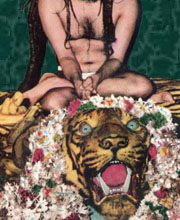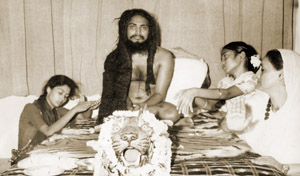Bhava Samadhi in Other Traditions
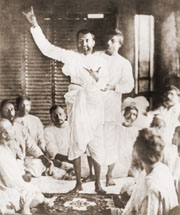
Above: Ramakrishna Paramahansa (1836–1886), mystic and yogi from Bengal, in bhava samadhi.
Below: Chaitanya Mahaprabhu (1486–1534) and followers singing bhajans and in bhava. Chaitanya, a social reformer in eastern India, is revered by followers as an incarnation of Lord Krishna. Chaitanya promoted the path of devotion (bhakti), particularly towards the Divine lovers, Radha and Krishna.
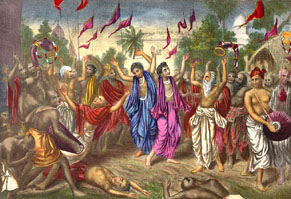
A Historical Perspective
There is nothing new or unique about bhava and bhava samadhi. They are as old as spiritual practice itself. The characteristics of bhava and bhava samadhi have been visibly manifest in almost all followers of the bhakti marga (the path of devotion). These characteristics are also manifest in followers of other spiritual paths.
Two examples are obvious to those familiar with the spiritual traditions of India. One can read accounts of the manifestations of bhava in the kirtan (bhajan) parties led by Sri Chaitanya and his chief disciple Nityananda. In more recent times, Paramahansa Ramakrishna was a living embodiment of bhava and all that it implies. His biographers have recorded that in accordance with the directions of the Divine Mother, he lived in bhavamukha [appearance of trance] all his life, and this notwithstanding the fact that he had attained to the ultimate non-dual state through nirvikalpa samadhi [samadhi where consciousness is completely dissolved in God].
Ecstatic states of spiritual trance (bhava samadhi) are part of all spiritual traditions, including those within Christianity (baptism of the Holy Spirit), Islam (Sufi dervishes), Tibetan Buddhism, and shamanism. They are expressions of Divine love.
Christians know bhava as the charisms or the gifts of the Holy Spirit — the supernatural graces of wisdom, knowledge, faith, healing, miracles, prophesy, discernment of spirits, and speaking in tongues. These are all benefits and manifestations of bhava.
Sufis are equally familiar with trance. It is the state of ecstasy that is the objective of the sama and dhikr ceremonies. The expression of trance is regulated for the whirling dervishes of the Mevlevi order, but many other Sufi traditions are much more openly expressive.
Mystical Sufi traditions in Northern India adopted bhajans to Persian poetry. The result was qawwali, an extremely powerful form of ecstatic music. There is a video of the Sabri Brothers performing a qawwali concert in Dubai. One can see men dancing in trance before the stage.
Shamans use music and dance to enter spiritual realms. In the traditions of ancient Greece and Rome, Dionysius, Bacchus, and the Delphic oracles are all associated with ecstatic states of trance. The cultures of the Levant, of which the Jewish prophets of the Old Testament are only one example, knew and valued spiritual trance.
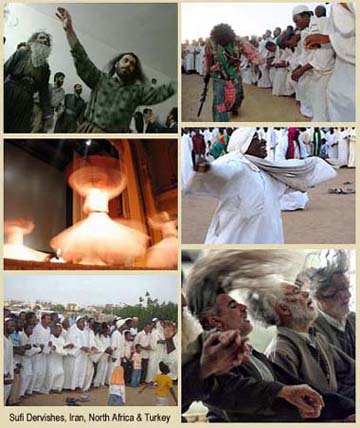
Uniqueness of Sri Swamiji’s Bhava Leela
Bhava has been a common feature of spiritual practice through the ages. What is unusual about Shivabalayogi’s bhava leela (the play of bhava) is the widespread and generous manner in which he evokes bhava to bring people to the spiritual path. Chaitanya and Sri Ramakrishna are known to have induced bhava in others, often on a large scale, but this was usually restricted to their chosen disciples and followers. In the case of Sri Swamiji, bhava spreads like an all engulfing wave whenever bhajans are conducted by his devotees, and almost all those present are affected by it to a greater or lesser extent.
We see the extraordinary sight of men and women of all ages, and particularly children, lost to the outer world in ecstasy, dancing to the beat of the devotional music, and exhibiting in themselves the characteristics of the Puranic gods and goddesses, yogis, and the ancient saints and rishis.
Another unique feature is that Sri Swamiji’s physical presence is not at all necessary for the manifestation of this bhava. Even when he was in his own physical body, he often was sitting in in his own room while bhajans may be going on in the meditation hall or in the ashram courtyard, and yet the manifestations of bhava went on just as if he was physically present. In fact Sri Swamiji could be thousand of miles away or, as he is now, in mahasamadhi, yet devotees will experience bhava whenever and wherever they may chose to play bhajans — after invoking his blessings.
It is Shivabalayogi's astral bodies that do the work. Now that Swamiji has dropped his physical form, his astral bodies continue the work.
![]()
